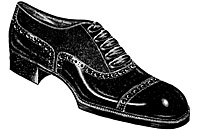The smoke and mirrors era of trade shows is over—at least, according to the show coordinators working overtime to reel retailers and exhibitors back to market this August. There is little argument amongst show management, manufacturers and retailers that the recession has ushered in a new landscape of wiser retailers with a sharp eye for value and exhibitors choosing to invest more in their product—not disposable trade show tricks. As Laura Conwell O’Brien, executive director of the Southeastern Shoe Travelers Association’s The Atlanta Shoe Market (TASM) puts it, “We’re about shoe business, not show business.”
It wouldn’t be trade show season, however, without tension in the air over show dates, travel expenses and competing exhibitor lists. Still, show directors are eager to expand upon the optimistic vibes of last February and working to make their respective markets a worthy stop on the circuit.
Three months out, shows are reporting “amazing retention” and “growth across the board.” FFANY president Joe Moore notes the show’s 30th year is shaping up to be its biggest ever. February’s attendance more than doubled from the year prior. Moore anticipates the next edition, taking place Aug. 3-5, will see a similar increase in traffic. “It’s proof that vendors are getting well covered by retailers and that FFANY is a buying and selling show,” he adds. WSA president Tom Nastos says now that the hardest edge of the economic downturn has passed, “people are feeling comfortable again and are looking for opportunities.”
Speaking of opportunities, relocating WSA (taking place Aug. 9-11) to Las Vegas’ Sands Expo—and securing that venue for the next five shows—was a chance to create the one-stop shop the show’s management sought. “People wanted WSA under one roof,” Nastos explains. “We’ve found a place that accommodates everyone. This will make it a significantly better show.”
The Atlanta show also banks on its convenience as a draw for retailers. “The beauty of TASM and part of its success is that the entire show [next taking place at the Cobb Galleria Centre Aug. 13-15] is all under one roof and it has an open booth format, which allows retailers to easily shop for new lines,” O’Brien notes. With time being a hot commodity, coordinators consider the single venue a big incentive for buyers. It’s a good move for manufacturers, too. TRU Show coordinator Phyllis Wright explains that having one roof means “exhibitors are all on a level playing field,” and it gives everyone the chance to see the breadth of the industry. [Go to trushow.com for show dates and locals.]
Retailers get a double dose of fashion at FN Platform (Aug. 17-19 at the Las Vegas Convention Center). Chris DeMoulin, president of Magic International and executive vice president of Advanstar Fashion Group, touts FN Platform as a well-merchandised, head-to-toe show—thanks in part to its shared roof with WWDMagic’s apparel market. “That is one major way FN Platform is different from the rest. You can see footwear with ready-to-wear and see how trends are represented across all fashion categories,” he says.
Coordinators agree that in order for a retailer to stay in business, buyers must bring in fresh inventory that addresses the comprehensive scope of the industry. “If you’re staying home and relying on reps, you’re isolating yourself from the rest of the market,” Nastos remarks.
According to Outdoor Retailer (OR) coordinator Kenji Haroutunian, this rings particularly true for its market, where consumers often rely on retailers’ technical recommendations. As such, he encourages retailers to attend OR’s Summer Market Open Air Demo (taking place Aug. 2, prior to the Aug. 3-6 show) at its new location, Salt Lake City’s Jordanelle Reservoir. There, they can field-test vendors’ new products. “Retailers are focused on what’s in their face now, but they have to think about the future,” he says. “The pace of change in this business is so fast,” he adds, noting that it includes the evolution of service, manufacturing and social media. At OR, attendees can stay connected through up-to-the-minute Twitter updates, while TRU Show is introducing a mobile app that allows buyers to locate booths by category on their handheld devices.
Reminders of the economic downturn still linger as shows seek ways to cut attendees’ costs via hotel deals, free lunch, local transportation and open seminars. Similarly, manufacturers have realized they don’t need gimmicky booths to draw attention. “These days, everyone is about the ROI and the bottom line,” O’Brien says. Leanne Milliken, marketing manager for the San Diego-based Action Sports Retailer show (happening Aug. 13-15), says that brands are being more realistic about spending, which suits retailers’ tastes.
“Giant corporate booths are intimidating and off-putting. People are tired of booths that are closed in with four walls and require a password to enter,” agrees DeMoulin. FN Platform’s inaugural show in February presented a sleek environment of simple white turnkey booths and lifestyle lounges (complete with a pool table, chandeliers and an abundance of foliage) which, according to DeMoulin, retailers enjoyed. “It was a welcoming environment,” he says. Nevertheless, DeMoulin reports that—upon vendor request—there will be more opportunity for branding going forward. Booth interiors will be tweaked this time around, he explains, but they won’t stray too far from the original concept.
At ASR, most exhibitors are electing to use turnkey booths to cut costs, Milliken notes. “Structures are expensive, but we’re allowing retailers to customize these structures,” she says, adding that exhibitors will be able to choose their preferred racks, shelves and graphics.
Just what the future of trade shows may hold remains to be seen. If the economy enters a boom phase perhaps a new booth arms race will ensue. “People overreact when the economy is good and when it is bad,” Nastos says. In the aftermath of recent seasons’ “doomsday vibes,” as Moore describes, even the smallest movements toward pre-recession business is a leap. “Shoes are not jumping off the shelf, but hell, it’s better than 2008,” Moore says. —Angela Velasquez




